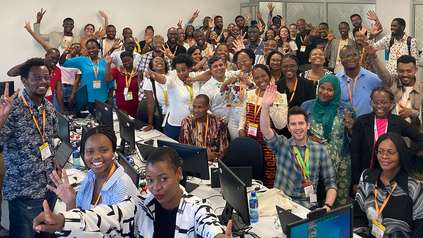Antimicrobial resistant bacteria and genes move freely between people, animals and the environment
An international collaboration led by researchers at the Wellcome Sanger Institute, Liverpool School of Tropical Medicine, the Malawi Liverpool Wellcome Programme, and others explored the transmission of resistance across Uganda and Malawi.
The research, published today (25 November) in Lancet Microbe, presents compelling evidence of widespread exchange of drug-resistant bacteria and genes across humans, animals, and the environment.
The results support taking a One Health approach when trying to stop the spread of AMR, providing genomic evidence that suggests that drug-resistant bacteria can move freely between humans, animals, and the environment in certain regions.
The One Health approach proposes that interventions for combating AMR should consider a holistic strategy. It recognises that the health of humans, animals and the environment is interconnected, and that effective AMR control requires coordinated action across all three compartments.
The researchers stress that integrated public health interventions are required, ones that take all transmission routes into account. For example, tracking antibiotic levels in livestock, wildlife, and wastewater, as well as humans.
AMR is a global health threat that causes more than 1.27 million deaths each year.1 Although it affects all countries, under-resourced countries have a particularly high burden, where poverty and inequality intensify its impact. Understanding AMR is critical to stopping its spread and protecting the effectiveness of lifesaving treatments.
This study, known as The DRUM study (Drivers of antimicrobial Resistance in Uganda and Malawi) analysed over 2,300 genomes of E. coli bacteria, revealing high genomic diversity across different One Health compartments: human, animal and the environment. The team collected E. coli isolates from human and animal stools as well as the environment at five sites across Uganda and Malawi. These were sequenced at the Sanger Institute and the whole genome sequences were used to assess relatedness and resistance-gene exchange between strains.
The team found no strong barriers limiting transmission of the bacteria or the genes encoding antibiotic resistance between human, animal and environmental sources. They also identified shared gene flow of AMR determinants across compartments, rather than each compartment being isolated or independent. This indicates that interventions focused on a single compartment – for example, antimicrobial stewardship programmes targeting humans only – may be insufficient. Parallel actions in animal and environmental settings, or consideration of resistance genes as independent entities, are also needed.
The study also uncovered multiple pathways for the spread of common genes that provide resistance to third-generation cephalosporins – antibiotics used to treat a range of bacterial infections – across different ecological compartments.
Together, these findings underscore a One Health challenge in which human, veterinary and environmental health are deeply interconnected. Crucially, the research suggests that in under-resourced settings, the spread of AMR genes might be more fluid than previously thought, meaning interventions must address all the compartments in an integrated way.
“Our study provides direct genomic evidence that antimicrobial resistance can move freely between humans, animals, and the environment and hence underscores the urgent need for truly One Health interventions for combating antimicrobial resistance. If we are ever able to slow the spread of treatment-resistant infections, we must take these different transmission routes into account and develop integrated public health interventions that address multiple ways that the bacteria can spread.”
Dr Patrick Musicha,
first author at the Malawi Liverpool Wellcome Programme, Liverpool School of Tropical Medicine and Wellcome Sanger Institute
“Strategies to slow the spread of antimicrobial resistance are only effective if we have the full picture, which is why genomic research is crucial to informing public health interventions. It also shows that we need to understand this problem in all settings given how connected we all are globally. This research shows that in under-resourced countries, traditional interventions and research that focus on the human clinical setting may miss the routes bacteria and the antimicrobial resistance genes they carry are spreading, including via animals. We hope that our work shows how important it is to focus on the gene as the ‘unit of transmission’ for AMR and that to be fully informed we need a true, holistic One Health approach to help reduce the burden of treatment-resistant infections.”
Professor Nick Thomsonsenior author at the Wellcome Sanger Institute
More information
Footnote
1. World Health Organization. Fact sheets – Antimicrobial Resistance. November 2023. Available at: https://www.who.int/news-room/fact-sheets/detail/antimicrobial-resistance [Last accessed: November 2025].
Publication
Musicha P, Beale MA, Cocker D, et al. (2025) Transmission of ESBL producing E. coli and antimicrobial resistance gene flow across One Health compartments in Eastern Africa: A whole genome sequencing study. Lancet 2025. DOI: 10.1016/j.lanmic.2025.101224
Funding
This study was funded by the UK Research and Innovation (UKRI), the National Institute for Health and Care Research (NIHR) and Wellcome.





